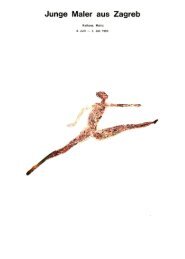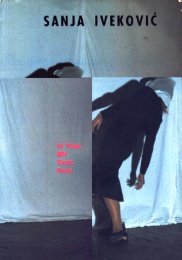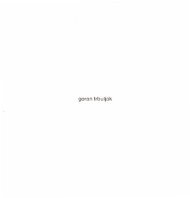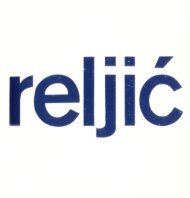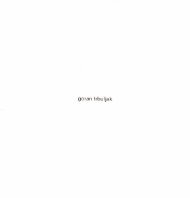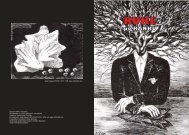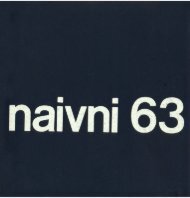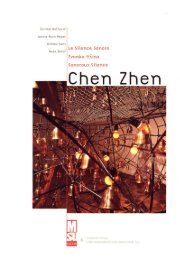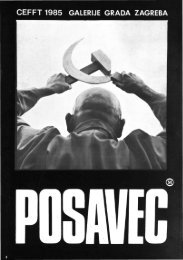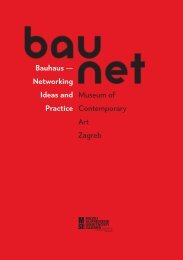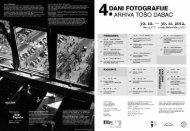The New Art Practice in Yugoslavia, 1966-1978
The New Art Practice in Yugoslavia, 1966-1978
The New Art Practice in Yugoslavia, 1966-1978
- TAGS
- practice
- yugoslavia
- www.msu.hr
Create successful ePaper yourself
Turn your PDF publications into a flip-book with our unique Google optimized e-Paper software.
and juxtapositions of materials created under the pressure of<br />
an authentic levell<strong>in</strong>g of reality with the objects. Once aga<strong>in</strong><br />
the OHO imag<strong>in</strong>ation stood under the <strong>in</strong>fluence of two ideas<br />
that came from Nez, accord<strong>in</strong>g to the pr<strong>in</strong>ciple "less is more»,<br />
he used a total levell<strong>in</strong>g of the materials (two planks, stuck<br />
<strong>in</strong>to the wall of the gallery and pushed <strong>in</strong>to a heap of soil<br />
<strong>in</strong> the centre of the room, Fig. 12) <strong>in</strong> order to present the<br />
elusive «draw<strong>in</strong>g» that could illustrate a different "system» of<br />
plastic organization of "form» <strong>in</strong> that suspicious-look<strong>in</strong>g<br />
object (which lacked the geometrical organization of form and<br />
me vertical organization of mean<strong>in</strong>g). Until the emergence of<br />
arte povera, the dignified artistic formulation <strong>in</strong> European<br />
culture could only be reached by means of metaphor, <strong>in</strong>vested<br />
with the sublimation of morals adapted to art. Nez's objects,<br />
however, reach that status through the establishment of their<br />
own materiality and the sensibility with which they were<br />
arranged. <strong>The</strong>re is an antagonism <strong>in</strong> this: the crude and<br />
simple materials were arranged with great sensibility for<br />
their physical properties and therefore the immediate<br />
identification and perception of the materials required an open,<br />
honest and lucid «draw<strong>in</strong>g.. Its only purpose was to describe<br />
their identity by means of the materials themselves not, of<br />
course, as a poetic or dada gesture, but <strong>in</strong> the sense of an<br />
attempt at formulation which is part of the aspired repertoire<br />
of the work of art and is, then, the equivalent of draw<strong>in</strong>g or<br />
pa<strong>in</strong>t<strong>in</strong>g).<br />
However, Nez's project Cosmology (Fig. 9) was even more<br />
important for the subsequent activity of the OHO group. David<br />
was ly<strong>in</strong>g <strong>in</strong> a circle, with a light bulb burn<strong>in</strong>g above him.<br />
<strong>The</strong> cosmology repesents an unexpla<strong>in</strong>ed mental syndrome,<br />
whose components the body, thought, light, memory,<br />
energy make up the first presentation of Body <strong>Art</strong> <strong>in</strong><br />
<strong>Yugoslavia</strong>. <strong>The</strong> message of David's action can be only of a<br />
spiritual nature: the earlier formal conceptualization has<br />
shifted to the sphere of consciousness, the mental flow of<br />
states, whose Gestalt cannot be determ<strong>in</strong>ed <strong>in</strong> practice. This<br />
was the first manifestation of the striv<strong>in</strong>g for transcedental<br />
conceptualism that is characteristic of the last year of OHO's<br />
activity.<br />
Andra Salamun and Milenko Matanovi were then go<strong>in</strong>g through<br />
a m<strong>in</strong>or crisis, which manifested itself <strong>in</strong> mannerism<br />
(Matanovi's Aeroplane Tires and Flanagan Ropes, Salamun's<br />
Hares and Wheelbarrows); however, Matanovi's composition<br />
<strong>The</strong> Moon deserves our attentien: it is a cont<strong>in</strong>uation of the<br />
experience of stretch<strong>in</strong>g the pa<strong>in</strong>t<strong>in</strong>g which can be observed<br />
from Ellsworth Kelly to Louis Can.<br />
In April Sreo Dragan and Marko Poganik rejo<strong>in</strong>ed the group.<br />
<strong>The</strong> latter arranged 154 hang<strong>in</strong>g "mobiles. quadrangular<br />
hang<strong>in</strong>g objects consist<strong>in</strong>g of cards with draw<strong>in</strong>gs accord<strong>in</strong>g<br />
to a strict numerical code. He wrote the programme of the<br />
arrangement with <strong>in</strong>scribed numerical cadenzes on impregnated<br />
canvas, which he laid on the floor of the gallery. <strong>The</strong> strictly<br />
determ<strong>in</strong>ed seriality, which is made up of the l<strong>in</strong>ear cont<strong>in</strong>uation<br />
of ascend<strong>in</strong>g numbers and a correspond<strong>in</strong>gly varied OHO<br />
cartoon draw<strong>in</strong>g on each card of the mobile, is a development<br />
of the Reistic experience. <strong>The</strong> firmly determ<strong>in</strong>ed operative<br />
programme of the arrangement of the mobiles <strong>in</strong> space is<br />
conf<strong>in</strong>ed to Reistic logics, but the arrangement creates the<br />
impression of a dynamic, witty game which has gone beyond<br />
the l<strong>in</strong>earism of Re/she imag<strong>in</strong>ation. Especially marked was<br />
the artist's effort to move his formulations from the standstill<br />
of Reistic universality.<br />
<strong>The</strong> last tribute to the structural rationality of Reism was the<br />
publicaton of PU, the last number of the journal Problemi,<br />
edited by I. Geister, R. Monik and M. Poganik. Its programme<br />
is characterized by the rigid circl<strong>in</strong>g of texts, messages and<br />
photographs <strong>in</strong> the four-polar division of the page. <strong>The</strong> circl<strong>in</strong>g<br />
is mechanical and is ruled by the simple l<strong>in</strong>ear logic of<br />
ascend<strong>in</strong>g numbers, <strong>in</strong> which the start<strong>in</strong>g po<strong>in</strong>ts are<br />
determ<strong>in</strong>ed by measur<strong>in</strong>g each contribution to the journal.<br />
While the OHO exhibition was held <strong>in</strong> Ljubljana, Toma<br />
Salamun opened his own show at the Preeren Gallery <strong>in</strong><br />
Kranj. Apart from variants of the exhibits from the Zagreb<br />
show (a pile of coal, iron fil<strong>in</strong>gs and the like), he covered the<br />
central gallery space with a 50 cm high layer of bundles of<br />
small boards and scrap wood tied with wire and thus<br />
familiarized the spectators with yet another form of<br />
conceptualist ideas. His other exhibits <strong>in</strong>cluded the project<br />
<strong>The</strong> Sea, which consisted of five uniformed young men ly<strong>in</strong>g<br />
down, over whom he had written the word sea with bread<br />
dough, and a number of photo-projects whith he documented<br />
his own conceptualist activity dur<strong>in</strong>g the w<strong>in</strong>ter of 1968 69.<br />
Though some of the scenes were <strong>in</strong>terest<strong>in</strong>g (Sculpture 117 C'<br />
Fig. 14), a general re-exam<strong>in</strong>ation was needed at the time of the<br />
use of the camera as a mach<strong>in</strong>e for copy<strong>in</strong>g» <strong>in</strong>stead of the<br />
traditional artistic procedures.<br />
By the spr<strong>in</strong>g of 1969 the techniques and imag<strong>in</strong>ation of<br />
the conceptualism characteristic of arte povera had been<br />
verified and carried to the ultimate limit of mean<strong>in</strong>gful<br />
consequences and the next step led out of gallery spaces <strong>in</strong>to<br />
nature and the natural environment, to research <strong>in</strong>to the four<br />
elements and their circl<strong>in</strong>g <strong>in</strong> natural processes, to the direct<br />
observation of m<strong>in</strong>eral and biological properties of the materials<br />
used <strong>in</strong> artistic work. <strong>The</strong> confrotation of man's states of m<strong>in</strong>d<br />
with the natural environment and its message became the theme<br />
of their activity dur<strong>in</strong>g the summer of 1969.<br />
In the freedom of life <strong>in</strong> nature, <strong>in</strong> the woods near the river<br />
Sava and Kokrica above Kranj, on the island of Srakane near<br />
Lo<strong>in</strong>j and <strong>in</strong> Kopar, the OHO group ventured <strong>in</strong>to new<br />
forms of activity. <strong>The</strong>y can be divided <strong>in</strong>to three categories:<br />
the shap<strong>in</strong>g of the visual language <strong>in</strong> an <strong>in</strong>teraction with the<br />
natural environment was the prov<strong>in</strong>ce of David Nez and<br />
Milenko Matanovi; Andra alamun enlarged the scope of his<br />
sensory experiences through various forms of Body <strong>Art</strong>: Marko<br />
Poganik, return<strong>in</strong>g to his old experiences, arrived at his own<br />
def<strong>in</strong>ition of the life of the four elements <strong>in</strong> nature and thus<br />
found the ideas and structures of the substratum of visions<br />
which he used <strong>in</strong> his work after 1971, at the time he and<br />
his family were liv<strong>in</strong>g at Sempas.<br />
In June 1969, Milenko Matanovi. who was at that time slightly<br />
<strong>in</strong>fluenced by the English "<strong>New</strong> Generation., mounted an<br />
exhibition by the Roman wall <strong>in</strong> the southern suburb of<br />
Ljubljana. He jo<strong>in</strong>ed four metre long poles, ty<strong>in</strong>g them with<br />
rope (Fig. 26). From simple triangular compositions, which he<br />
leaned aga<strong>in</strong>st the wall, he progressed to a more and more<br />
complex spatial draw<strong>in</strong>g, <strong>in</strong> which the form was conta<strong>in</strong>ed <strong>in</strong><br />
the limitless frame of air and light and where it was only<br />
necessary to tighten the rope to obta<strong>in</strong> a different shape.<br />
<strong>The</strong>se situational sculptures with a stressed aesthetic note<br />
and harmonious effects were nevertheless created <strong>in</strong> a<br />
proto-exhibition environment, because the Roman wall was<br />
presented as an archeological site under conservation and<br />
thus carried the restrictions of what may be termed the greater<br />
gallery environment. But when Matanovi placed <strong>in</strong>to the<br />
Ljubljanica River a long snake (Fig. 20) consist<strong>in</strong>g of scores of<br />
poles connected with a rope, the logical consequence of this<br />
<strong>in</strong>tervention <strong>in</strong>to the urban environment led him to a forest<br />
near Kranj. <strong>The</strong>re he arranged long poles and bands among<br />
the branches and trees, mak<strong>in</strong>g a symetrical, rhythmical and<br />
dynamic composition. It seemed as if the aesthetic will were<br />
the last trace of the gallery experience, because the stretched<br />
arches of the poles or the poles lean<strong>in</strong>g aga<strong>in</strong>st tree branches<br />
blended with the rustl<strong>in</strong>g of the leaves, the flow of light and<br />
the movement of the vegetation, which was now the "material»<br />
world of Milenko's project, the true matter of the situation <strong>in</strong><br />
which the visual <strong>in</strong>tervention was tak<strong>in</strong>g place. Matanovi had<br />
found the situational aesthetics, the <strong>in</strong>terpetation of nature<br />
and the visual <strong>in</strong>tervention <strong>in</strong> it <strong>in</strong> the form of a semantically<br />
elusive field, <strong>in</strong> which the body and its <strong>in</strong>def<strong>in</strong>able disposition<br />
to the environment determne the way <strong>in</strong> which the aesthetic<br />
<strong>in</strong>formation provided by the sight should be treated and<br />
arranged <strong>in</strong>to a transparent, open and ephemeral sculpture and<br />
scenery. This was the orig<strong>in</strong> of the conceptual idea <strong>in</strong> the form<br />
of a complex guide to the artist's sensory experiences:<br />
because it is only when we have complemented the aesthetically<br />
arranged image of the poles, placed among the trees with the<br />
sound background of the forest, the heat radiation of<br />
the earth, the physical perception of the objects that surround<br />
us, the spatial <strong>in</strong>tuition which can accept only the pure and<br />
immediate experience of the touch, the nearness of the trees,<br />
bushes and water, that we can grasp the mean<strong>in</strong>g of Matanovi's<br />
experiments. It would be false to assume that <strong>The</strong> Rope (Fig. 23)<br />
which bends the grow<strong>in</strong>g wheat, is an extension of aesthetic<br />
practice <strong>in</strong>to nature or that it is an <strong>in</strong>dividual event or the<br />
registration of an orig<strong>in</strong>al gimmick: the hand that holds the<br />
rope, the bend<strong>in</strong>g of the ears of wheat accompanied by the<br />
summer heat and the allusions which range from bread to<br />
transformations <strong>in</strong> life all that grows <strong>in</strong>to one mental<br />
15



